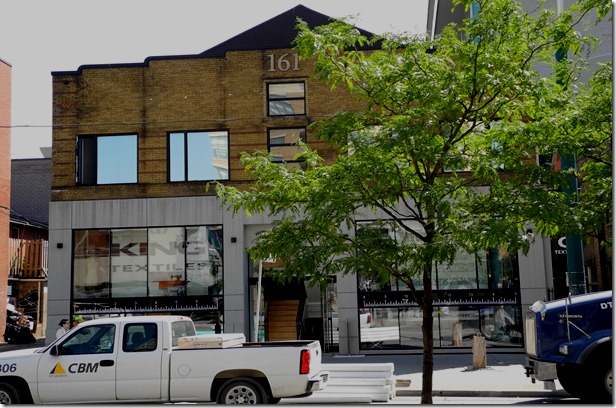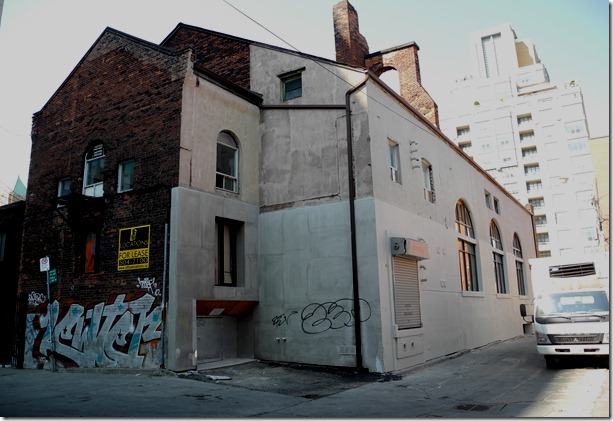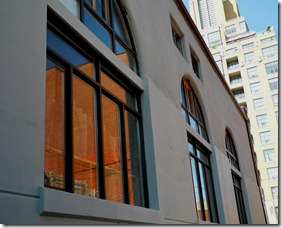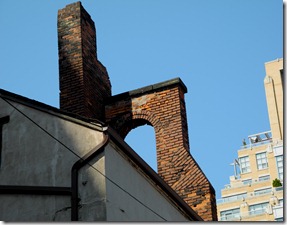Have you ever passed this building on the east side of Spadina, a short distance south of Queen Street? The nineteenth-century building behind the modern facade is entirely hidden from view. Only the peaked roof of the 1890s building behind the modern addition is now visible from the street.
This is how the site appear in the last century. The Episcopal Church of St. Margaret’s was constructed at 161 Spadina Avenue in 1890. It ceased to function as a church in 1911 and was converted into a factory. It became site of the facilities of Caulfield, Burns and Gibson Ltd. When the above photo from the Toronto Archives was taken, about 1920, the church was already a factory. The bells in the belfry had been removed.
However, from the rear of the building, St. Margaret’s Church is clearly visible. The laneway on the north side of the church, where the truck was named parked Perry Lane. It was named after Mrs. Perry, who in the 1880s lived in one of the three small dwellings that were located on the north side of the laneway. Today the lane is named “Lot St. Lane.”
Church windows on the north side The old belfry that once held bells.
This photo was taken in 1909, when St. Margaret’s remained a functioning church. A portion of it can be seen on the left-hand side of the picture. The view is of Spadina Avenue, looking south from Queen Street. In this picture, a structure is evident in the centre of the roadway, where there is a small fence and a pole. It is where stairs led down to a men’s underground washroom.
To view the Home Page for this blog: https://tayloronhistory.com/
To view previous posts about movie houses of Toronto—old and new
https://tayloronhistory.com/2013/10/09/links-to-toronto-old-movie-housestayloronhistory-com/
To view links to other posts placed on this blog about the history of Toronto and its heritage buildings:
https://tayloronhistory.com/2013/10/08/links-to-historic-architecture-of-torontotayloronhistory-com/
Recent publication entitled “Toronto’s Theatres and the Golden Age of the Silver Screen,” by the author of this blog. The publication explores 50 of Toronto’s old theatres and contains over 80 archival photographs of the facades, marquees and interiors of the theatres. It also relates anecdotes and stories from those who experienced these grand old movie houses.
To place an order for this book:
Theatres Included in the Book
Chapter One – The Early Years—Nickelodeons and the First Theatres in Toronto
Theatorium (Red Mill) Theatre—Toronto’s First Movie Experience and First Permanent Movie Theatre, Auditorium (Avenue, PIckford), Colonial Theatre (the Bay), thePhotodome, Revue Theatre, Picture Palace (Royal George), Big Nickel (National, Rio), Madison Theatre (Midtown, Capri, Eden, Bloor Cinema, Bloor Street Hot Docs), Theatre Without a Name (Pastime, Prince Edward, Fox)
Chapter Two – The Great Movie Palaces – The End of the Nickelodeons
Loew’s Yonge Street (Elgin/Winter Garden), Shea’s Hippodrome, The Allen (Tivoli), Pantages (Imperial, Imperial Six, Ed Mirvish), Loew’s Uptown
Chapter Three – Smaller Theatres in the pre-1920s and 1920s
Oakwood, Broadway, Carlton on Parliament Street, Victory on Yonge Street (Embassy, Astor, Showcase, Federal, New Yorker, Panasonic), Allan’s Danforth (Century, Titania, Music Hall), Parkdale, Alhambra (Baronet, Eve), St. Clair, Standard (Strand, Victory, Golden Harvest), Palace, Bedford (Park), Hudson (Mount Pleasant), Belsize (Crest, Regent), Runnymede
Chapter Four – Theatres During the 1930s, the Great Depression
Grant ,Hollywood, Oriole (Cinema, International Cinema), Eglinton, Casino, Radio City, Paramount, Scarboro, Paradise (Eve’s Paradise), State (Bloordale), Colony, Bellevue (Lux, Elektra, Lido), Kingsway, Pylon (Royal, Golden Princess), Metro
Chapter Five – Theatres in the 1940s – The Second World War and the Post-War Years
University, Odeon Fairlawn, Vaughan, Odeon Danforth, Glendale, Odeon Hyland, Nortown, Willow, Downtown, Odeon Carlton, Donlands, Biltmore, Odeon Humber, Town Cinema
Chapter Six – The 1950s Theatres
Savoy (Coronet), Westwood
Chapter Seven – Cineplex and Multi-screen Complexes
Cineplex Eaton Centre, Cineplex Odeon Varsity, Scotiabank Cineplex, Dundas Square Cineplex, The Bell Lightbox (TIFF)

![f1244_it1735[1] f1244_it1735[1]](https://tayloronhistory.com/wp-content/uploads/2012/07/f1244_it17351_thumb1.jpg)



![f1244_it7167[1] f1244_it7167[1]](https://tayloronhistory.com/wp-content/uploads/2012/07/f1244_it71671_thumb.jpg)
![cid_E474E4F9-11FC-42C9-AAAD-1B66D852[1] cid_E474E4F9-11FC-42C9-AAAD-1B66D852[1]](https://tayloronhistory.com/wp-content/uploads/2014/10/cid_e474e4f9-11fc-42c9-aaad-1b66d8521_thumb2.jpg)

